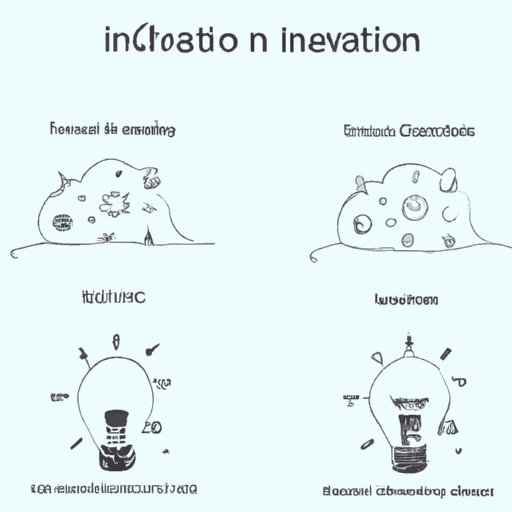Exploring the Contrast: Invention vs Innovation
Innovation and invention are two concepts that have become increasingly popular in the modern business world. But what exactly is the difference between these two ideas? In this article, we’ll be exploring the contrast between invention and innovation, so you can better understand how to use them to your advantage.
The Difference Between Invention and Innovation
To start, let’s first define the terms “invention” and “innovation.” Invention is the creation of something that has never existed before. This could include a product, a process, or even an idea. According to a study by the National Academy of Sciences, “Inventions are new products, devices, processes, or methods that have practical applications.”
Innovation, on the other hand, is the improvement or enhancement of an existing idea, product, process, or method. Whereas invention is the conception of something new, innovation is the refinement of an existing concept. For example, if someone invented a new type of car, they might later innovate it by making it more fuel-efficient or adding additional safety features.

A Comprehensive Guide to Invention and Innovation
Now that we’ve established the distinction between invention and innovation, let’s take a look at the processes involved in each. Understanding the process of inventing and innovating is key to being able to differentiate between the two concepts.
Understanding the Process of Inventing
Inventing something new is not a simple task. It requires knowledge, experience, and creativity. Generally speaking, the process of inventing involves the following steps:
- Brainstorming potential solutions to a problem
- Researching relevant topics and materials
- Developing a prototype or model
- Testing and refining the prototype
- Securing patent protection
- Marketing and selling the invention
Steps for Innovating
Innovating an existing product or idea is a much simpler process than inventing something from scratch. Generally, the process of innovating involves the following steps:
- Identifying areas for improvement
- Brainstorming potential solutions
- Researching relevant topics and materials
- Developing a prototype or model
- Testing and refining the prototype
- Implementing the changes

How to Tell the Difference Between Inventing and Innovating
So how can you tell the difference between inventing and innovating? The key is to identify the problem you’re trying to solve. If you’re attempting to create something that has never existed before, then you’re inventing. If you’re attempting to improve or enhance an existing idea, then you’re innovating.
Analyzing the Problem
When analyzing a problem, ask yourself these questions: Is there already a solution to this problem? Is there a way to make the existing solution better? If the answer to either of those questions is yes, then you’re likely dealing with an innovation opportunity rather than an invention.
Examining Possible Solutions
Once you’ve identified a problem, consider the possible solutions. Are you coming up with something that’s never been done before? Or are you looking to improve upon an existing idea? Once you’ve identified the type of solution you’re working with, you’ll know whether you’re dealing with an invention or an innovation.

What You Need to Know About Invention and Innovation
In addition to understanding the processes of inventing and innovating, it’s also important to be aware of the different types of inventions and innovations. Knowing the types of inventions and innovations can help you identify which one you’re dealing with.
Types of Inventions
Inventions can be divided into three categories: mechanical, chemical, and electrical. Mechanical inventions involve the use of machines or tools to create something new. Chemical inventions involve the use of chemicals to create something new. Electrical inventions involve the use of electricity to create something new.
Types of Innovations
Innovations can be divided into four categories: product, process, service, and business model. Product innovations involve improving or enhancing an existing product. Process innovations involve improving or enhancing an existing process. Service innovations involve improving or enhancing an existing service. Business model innovations involve improving or enhancing an existing business model.
Comparing and Contrasting Invention and Innovation
Now that we’ve established the definitions and types of invention and innovation, let’s compare and contrast the two concepts. There are both pros and cons to each approach, as well as benefits to combining them.
Pros and Cons of Invention vs. Innovation
Inventions can be extremely rewarding, but they can also be risky. The risk comes from the fact that there’s no guarantee that your invention will be successful. On the other hand, innovations are less risky because you’re building upon something that already exists. However, innovations may not provide the same level of reward as inventions.
Benefits of Combining Invention and Innovation
Combining invention and innovation can provide the best of both worlds: the reward of creating something new and the safety of improving something existing. By combining the two approaches, you can maximize your chances of success while minimizing your risk.
In conclusion, understanding the distinction between invention and innovation is essential for any entrepreneur or innovator. Invention involves creating something new, while innovation involves improving or enhancing an existing idea. Both processes have their own pros and cons, but combining the two approaches can bring the best of both worlds.
(Note: Is this article not meeting your expectations? Do you have knowledge or insights to share? Unlock new opportunities and expand your reach by joining our authors team. Click Registration to join us and share your expertise with our readers.)
